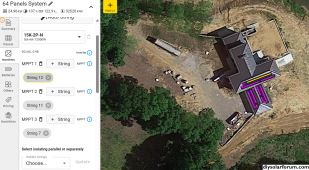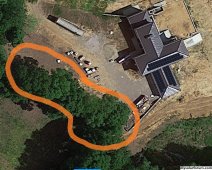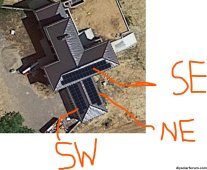DIYsolarKY
New Member
So I think the everyone on the forum has convinced me to go ahead and design my own and do my own DIY solar installation.
It pushed me over the edge when I got up on my standing seam roof and it was flat as a board, easy to walk on and my wife reminded me that the savings of DIY would allow us to have a massive battery bank.
House is newly built, on the grid, been in it a year, already crushing electricity, 5 girls at home, my wife too, massive house, endless list of appliances, two big AC compressors, two minisplits, washer, dryer, furnaces, in floor radiant electric heating in winter for master suite, tankless propane water heaters and propane for heating furnaces, 5 TVs, so many hair dryers... The list doesn't end
I have an option to do net metering so that is definitely the plan.
House has 400 amp service
Planning two solark 15 kpv inverters (too may positive reviews on here about this product just working well - I'm just not ready to go with the EG4 18 kpv yet, maybe 5 years from now once it has been around awhile longer and I will be kicking myself),
25-28 kw PV array, next question is where to get supplies and I need help with the design.
I have been on opensolar.com. I think I need to get on ironridge to make a more firm designs for solar racking.
I have a standing seam roof and there is an ice rail installed on the bottom near gutter with S5-T clamps and a railing system.
Can i use this as the lower rail for my panels?
I have found panels for sale by the pallet on signature solar for as low as 29 c/watt up to 52c/watt? Anywhere else I should be looking for pallets of panels?
I have been quoted for about 100 kw of use a day to get a 25-28 kw PV array.
I have been told that silfab, canadian solar, Q cells are the best quality panels, but have also been told that most panels are going to be good for 25 years and doesn't really matter what panels we get.
Opensolar.com has a function that creates strings based on the panels that are placed on the googlemaps roof.
I have basically one main SE facing section of roof and two other less optimal areas (one basically facing NE and the other SW). So three different pitches of the roof we are planning to put panels on.
I have been on my roof and done some measurements to try and confirm to help with the design.
One of the solar companies that quoted me said I need to worry about shading. They were touting using microinverters per panel or using optimizers for strings of panels.
Anyone have any feedback on why I might need optimizers? My house is nearly on top of a hill but there are some 80 ft trees just above us that shade the roof partially towards the end of the day. Does this shading mean I need optimizers? I don't really know enough about that issue. Obviously the end or beginning of each day is going to have shading issues everywhere when the sun is not more directly overhead.
I have really no idea what to do as far as string design - I have done plenty of reading here and elsewhere, but I assume this is all about how much DC voltage and amperage I can have per MPPT input into each solark input (in parallel increase amperage and in series increases voltage.)
Can I rely on the autostring function on the opensolar website, anyone bold enough to have already done this? can I just do some simple math and add up the max voltage and amperage per solar panel in each string to come up with or verify the design doesn't go over the specs on the solark inputs?
And what about getting all the proper wire sizes and lengths, I'm guessing I need ofc a large sketch of a big diagram with each string, how do I know if I need a combiner box and is that the same place a RSD goes? one solar company told me that here in kentucky that they don't even require an RSD outside, i was shocked that I guess our electric codes maybe from the stone age here.
I am looking around locally for an electrician to help connect the inverters to the main panel and meter.
I am going to fill out the net metering application and try and figure out where I need to go to get a permit for this project.
what else should I be worried about or doing in the meantime.
Any and all help is more than appreciated.
A big thanks in advance to the community of DIYers who contribute on this site. Without Will and this community no way would I consider this.

It pushed me over the edge when I got up on my standing seam roof and it was flat as a board, easy to walk on and my wife reminded me that the savings of DIY would allow us to have a massive battery bank.
House is newly built, on the grid, been in it a year, already crushing electricity, 5 girls at home, my wife too, massive house, endless list of appliances, two big AC compressors, two minisplits, washer, dryer, furnaces, in floor radiant electric heating in winter for master suite, tankless propane water heaters and propane for heating furnaces, 5 TVs, so many hair dryers... The list doesn't end
I have an option to do net metering so that is definitely the plan.
House has 400 amp service
Planning two solark 15 kpv inverters (too may positive reviews on here about this product just working well - I'm just not ready to go with the EG4 18 kpv yet, maybe 5 years from now once it has been around awhile longer and I will be kicking myself),
25-28 kw PV array, next question is where to get supplies and I need help with the design.
I have been on opensolar.com. I think I need to get on ironridge to make a more firm designs for solar racking.
I have a standing seam roof and there is an ice rail installed on the bottom near gutter with S5-T clamps and a railing system.
Can i use this as the lower rail for my panels?
I have found panels for sale by the pallet on signature solar for as low as 29 c/watt up to 52c/watt? Anywhere else I should be looking for pallets of panels?
I have been quoted for about 100 kw of use a day to get a 25-28 kw PV array.
I have been told that silfab, canadian solar, Q cells are the best quality panels, but have also been told that most panels are going to be good for 25 years and doesn't really matter what panels we get.
Opensolar.com has a function that creates strings based on the panels that are placed on the googlemaps roof.
I have basically one main SE facing section of roof and two other less optimal areas (one basically facing NE and the other SW). So three different pitches of the roof we are planning to put panels on.
I have been on my roof and done some measurements to try and confirm to help with the design.
One of the solar companies that quoted me said I need to worry about shading. They were touting using microinverters per panel or using optimizers for strings of panels.
Anyone have any feedback on why I might need optimizers? My house is nearly on top of a hill but there are some 80 ft trees just above us that shade the roof partially towards the end of the day. Does this shading mean I need optimizers? I don't really know enough about that issue. Obviously the end or beginning of each day is going to have shading issues everywhere when the sun is not more directly overhead.
I have really no idea what to do as far as string design - I have done plenty of reading here and elsewhere, but I assume this is all about how much DC voltage and amperage I can have per MPPT input into each solark input (in parallel increase amperage and in series increases voltage.)
Can I rely on the autostring function on the opensolar website, anyone bold enough to have already done this? can I just do some simple math and add up the max voltage and amperage per solar panel in each string to come up with or verify the design doesn't go over the specs on the solark inputs?
And what about getting all the proper wire sizes and lengths, I'm guessing I need ofc a large sketch of a big diagram with each string, how do I know if I need a combiner box and is that the same place a RSD goes? one solar company told me that here in kentucky that they don't even require an RSD outside, i was shocked that I guess our electric codes maybe from the stone age here.
I am looking around locally for an electrician to help connect the inverters to the main panel and meter.
I am going to fill out the net metering application and try and figure out where I need to go to get a permit for this project.
what else should I be worried about or doing in the meantime.
Any and all help is more than appreciated.
A big thanks in advance to the community of DIYers who contribute on this site. Without Will and this community no way would I consider this.







